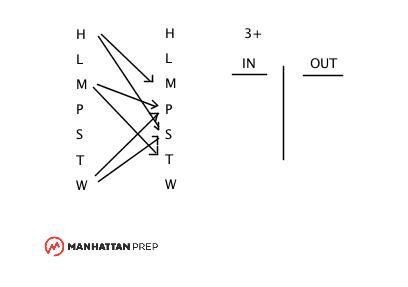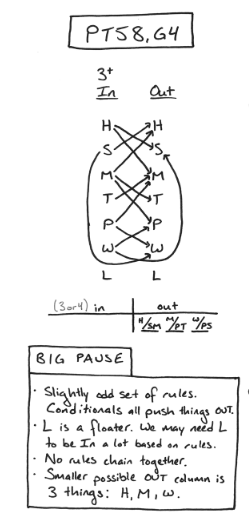
LSAT Forum
5 postsPage 1 of 1
-

- ManhattanPrepLSAT1
-
Thanks Received: 1909
-
Atticus Finch

- Posts: 2851
- Joined: October 07th, 2009
-

- mmcnary
-
Thanks Received: 0
-
Vinny Gambini

- Posts: 7
- Joined: January 31st, 2017
Re: Diagram
I'm confused why only the first part of each rule seems to be in this diagram- if H is taken the neither S nor M can be taken, I see that in the chart but don't we also need to do the inverse that then if M or S is taken H is not taken
-

- ohthatpatrick
-
Thanks Received: 3808
-
Atticus Finch

- Posts: 4661
- Joined: April 01st, 2011
- This post thanked 2 times.
-

- raqueljpaul
-
Thanks Received: 0
-
Vinny Gambini

- Posts: 5
- Joined: September 27th, 2016
Re: Diagram
Is there another way to diagram this game? I feel like no matter what I keep getting lost in the inference chain...just too many arrows everywhere and it's slowing me down. For example, could I just do a table? Also, what clues should I use to know whether or not the Inference Chain is the best option?
Thanks!
Thanks!
-

- ohthatpatrick
-
Thanks Received: 3808
-
Atticus Finch

- Posts: 4661
- Joined: April 01st, 2011
- This post thanked 1 time.
Re: Diagram
Sure, you can always approach any In/Out game by just
1. Set up each conditional AND its contrapositive
(2. Chain together any conditionals that link)
If you really hate up front organization, then skip step 2 and just go plug and chug with the whole thing.
RULES:
....... H --> ~S and ~M
S or M --> ~H
--------------------
........ M --> ~P and ~T
P or T --> ~M
--------------------
....... W --> ~P and ~S
P or S ---> ~W
At this point, you'd look to see if any of these chain together. Doing so means taking each right side idea and asking if it's a trigger somewhere else.
For example for the first line,
"Does ~S or ~M trigger anything?"
Since none of the rules have ~S or ~M as a trigger, the first line doesn't chain.
With this game, we might quickly realize that ALL the right side ideas are negative (OUT column), and NONE of the triggers are negative.
So none of these right side ideas will trigger any of the left sides of the other conditionals.
Since none of the rules chain together, we're done with the setup and ready to go to the questions.
We should note that L is a floater, somewhere on our roster of characters.
======================
If we don't understand how the placeholders in the OUT column work, then this game will involve a lot of plug-n-chug. That's fine, if that's the way you'd prefer doing it.
The most salient observation with this setup is, "Huh --- all these rules are forcing things out, and I have a MINIMUM of three things in. It might be hard to get enough things to stay IN. I'll have to really watch out that I don't get more than 4 things OUT."
Most of the questions are driven by the motivation of keeping your OUT column to 4 ppl or less.
======================
The logic chain is well suited to games with all conditional rules, where some of the people show up in multiple rules.
It doesn't do much for us here, since none of the rules chain together, but that's a very unexpected development. Game 2 in this same test (test 58) plays out the way we WOULD expect an In/Out game to feel, and there the Logic Chain seems to do more for us in the end, because many rules DO chain together.
If you don't like the Logic Chain and instead prefer the idea of writing out conditionals (and their contrapositives), whenever you see them, just use that method always.
Just remember, whenever you have a conditional rule, you ask yourself, "Does the right side of this rule trigger something else?"
1. Set up each conditional AND its contrapositive
(2. Chain together any conditionals that link)
If you really hate up front organization, then skip step 2 and just go plug and chug with the whole thing.
RULES:
....... H --> ~S and ~M
S or M --> ~H
--------------------
........ M --> ~P and ~T
P or T --> ~M
--------------------
....... W --> ~P and ~S
P or S ---> ~W
At this point, you'd look to see if any of these chain together. Doing so means taking each right side idea and asking if it's a trigger somewhere else.
For example for the first line,
"Does ~S or ~M trigger anything?"
Since none of the rules have ~S or ~M as a trigger, the first line doesn't chain.
With this game, we might quickly realize that ALL the right side ideas are negative (OUT column), and NONE of the triggers are negative.
So none of these right side ideas will trigger any of the left sides of the other conditionals.
Since none of the rules chain together, we're done with the setup and ready to go to the questions.
We should note that L is a floater, somewhere on our roster of characters.
======================
If we don't understand how the placeholders in the OUT column work, then this game will involve a lot of plug-n-chug. That's fine, if that's the way you'd prefer doing it.
The most salient observation with this setup is, "Huh --- all these rules are forcing things out, and I have a MINIMUM of three things in. It might be hard to get enough things to stay IN. I'll have to really watch out that I don't get more than 4 things OUT."
Most of the questions are driven by the motivation of keeping your OUT column to 4 ppl or less.
======================
The logic chain is well suited to games with all conditional rules, where some of the people show up in multiple rules.
It doesn't do much for us here, since none of the rules chain together, but that's a very unexpected development. Game 2 in this same test (test 58) plays out the way we WOULD expect an In/Out game to feel, and there the Logic Chain seems to do more for us in the end, because many rules DO chain together.
If you don't like the Logic Chain and instead prefer the idea of writing out conditionals (and their contrapositives), whenever you see them, just use that method always.
Just remember, whenever you have a conditional rule, you ask yourself, "Does the right side of this rule trigger something else?"
5 posts Page 1 of 1
